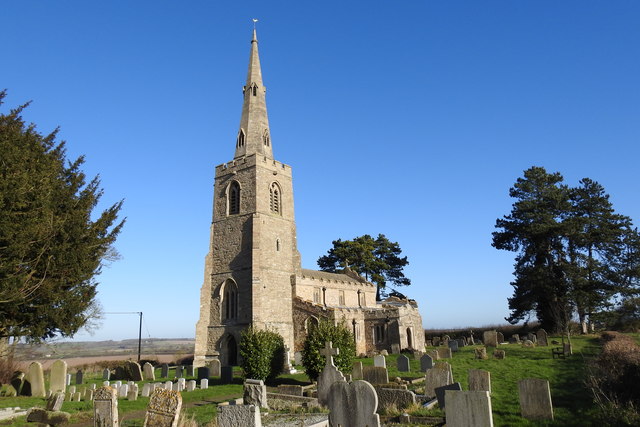All Saints church, Little Staughton
Introduction
The photograph on this page of All Saints church, Little Staughton by Adrian S Pye as part of the Geograph project.
The Geograph project started in 2005 with the aim of publishing, organising and preserving representative images for every square kilometre of Great Britain, Ireland and the Isle of Man.
There are currently over 7.5m images from over 14,400 individuals and you can help contribute to the project by visiting https://www.geograph.org.uk

Image: © Adrian S Pye Taken: 18 Jan 2020
From the church's website The history of All Saints Church can be traced back to 12th century although it is likely that the present church occupies a much older site of worship. Approximately a quarter of a mile due east of the church is a moated enclosure which was the stronghold of Sir Adam de Creeting, one of the knights of Edward I. The church has early links with the Knights Templar who held land in the village and had a preceptory in the nearby village of Melchbourne. The Church's Patron between 1245 and about 1330 was the Master of the Templars in England. From 1639, the Patron has been Corpus Christi College Oxford. A chalice with cover paten (which is not kept in the church) bears the arms of Bishop Fox of Winchester who was founder of the college. For much of its existence the church was dedicated to St Margaret, a 4th century Virgin Martyr from Antioch who was one of the most popular saints in the early English Church. The church's name was changed to All Saints at some time during the 19th century for reasons which have been lost but the link with St Margaret was re-established when the church's small side chapel was re-dedicated to her in 1937 on the tenth Sunday after Trinity which was close to her traditional feast day of 20th July. The nave was built in 13th century and the south aisle in 14th century. In 15th century, the chancel was rebuilt and the tower added. The tower still contains one bell which was made in about 1450 by a woman foundress called Johanna Hille. The church, like many others, suffered badly during the Reformation when its medieval decoration, furnishings, statues and stained glass were all destroyed. Between 1644 and 1647, the living of Little Staughton was sequestered to help pay the cost of the Civil War. During the 18th century the internal appearance of church changed to reflect the religious fashions of the times. The church acquired a west gallery and a three-tier pulpit and desk. There were a number of enclosed pews including the Squire’s seat which was described in 1852 as “flaming with scarlet and gold, elevated and o’ertopping all”. During the 19th century efforts were made to keep the church in good repair but these were inhibited when lead was stolen from the roof and the spire damaged by lightning in the 1830s. However, some changes were made including the raising of the Chancel roof above the 15th century one to give it a steeper pitch. In 1900 the spire was partially demolished by lightning and considerable damage was caused to the west end of the church. The treble bell was also damaged when the spire fell and had to be recast. The truncated spire was capped and, when the church reopened in 1901, the west gallery had been removed along with the enclosed pews. Six years later, in August 1906 disaster struck again when the leaded windows in the west belfry and the west side of the south aisle were severely damaged in the "phenomenal storm" which hit the village with lightning, high winds and hail stones said to be the size "2 shilling pieces". (28.5 mm)

